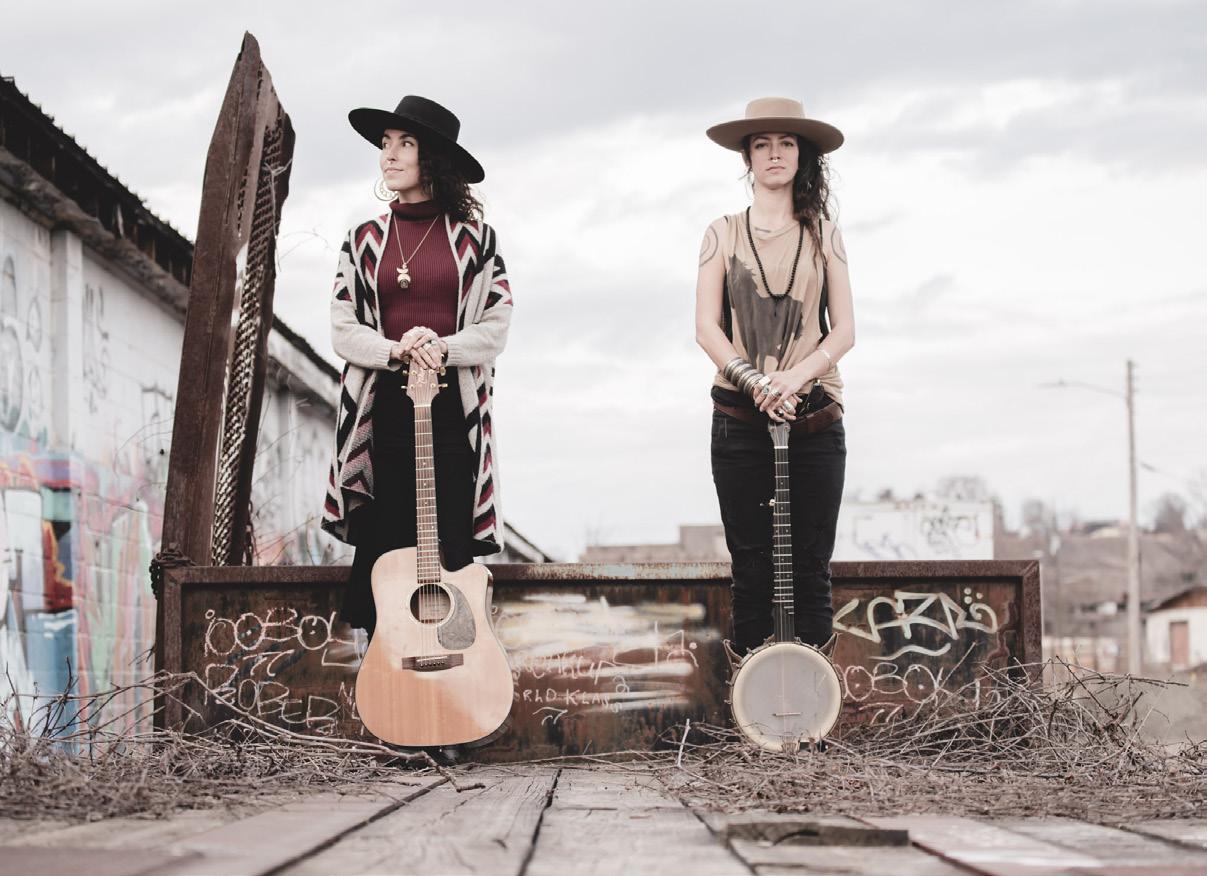
19 minute read
Bridging Worlds With Rising Appalachia
By Chris Assaad
During these times of great planetary change and uncertainty, the many ways in which humanity is divided are becoming undeniable and the need for unity, harmony, and synergistic co-creation are evermore apparent. As we collectively lean deeper into this significant moment in history and look for a path forward, an ancient, timeless modality for catalyzing evolution and supporting healing is being rediscovered and renewed. As outdated societal norms, systems, and structures are crumbling—and those in positions of power, once entrusted to lead, are being more highly scrutinized—a new wave of rebel leadership is emerging to support the movement towards a more lifeaffirming, equitable, inclusive, and sustainable future.
Advertisement
Enter sisters Leah and Chloe Smith, founders and co-creators of the folk roots band, Rising Appalachia. Both are fierce music medicine women, mystics, singer-songwriters, multi-instrumentalists, word-weavers, dedicated activists, and wayshowers. Each forms one half of the heart-trust of a multi-faceted collaborative endeavor that encompasses a wide range of passions and expressions, and that extends in reach well beyond their impressive independent success as artists. Born of a gentle beginning, fueled by passion and resilience, organically-grown out of a strong blood bond and deep family roots, Rising Appalachia has evolved into a force of nature that encompasses a potent blend of changemaking artistry and relentless real world activism. Bridgers of worlds old and new, visible and invisible, the band has gathered a global family of allies through the unifying force of music, sacred song, and a common cause.
On their most recently released full-length album, Leylines, Rising Appalachia reveal the fruits of a well-worn path of world travel, adventure, and experience. Their seventh album, the first to be birthed with a producer and to be recorded outside of the South, was captured mostly live and stunningly displays the ripening of Leah and Chloe’s many crafts well-honed on their journey since answering the calling to join creative forces nearly two decades ago. On Leylines, Rising Appalachia seamlessly weave their individual and shared gifts for storytelling, wisdom-filled wordplay and sonic spellbinding, beautifully blending elements of their southern roots and upbringing with the flavours and textures of a global tapestry of influences. The resulting work of art is a rich, deep, cohesive and soulfilling offering that is the perfect companion to those seeking a soundtrack to aid in connecting the dots, both within and without, amidst these times of uncertainty. Indeed, Leylines is much needed medicine for the massive waves of change and kindling for the fires of transformation that are burning strong at this moment in time.
In this FtC Conscious Artist Feature, we caught up with Chloe Smith of Rising Appalachia and got a deeper insight into the band’s inspiration and personal take on all things music, art, activism, and the current state of affairs in the world. Chloe openly shares about the ways in which this time of “great pause” has informed Rising Appalachia’s direction forward and vision for what’s to come, and the essential ways in which music and art can contribute to the collective process of change and healing that are unfolding. Chloe also sheds some light on the coming to fruition of a lifelong dream collaboration with their “all-time favorite righteous musician/activist/hero/ babe”, Ani DiFranco, who is a featured guest on “Speak Out”—a fiery, anthemic protest song and call-to-action from the new album. The feature also includes a question from our readers and some sage advice for anyone looking to use their voice and express more fully. In the spirited, thought-stirring, artful responses shared, we get a true taste of the creativity, medicine, and experiential wisdom that infuse Rising Appalachia’s music, message, and mission. It’s amazing, really, how a seed of an idea or a dream comes to fruition. Sometimes, it’s instant like lightning. Sometimes, it’s a slow wave coming in from “ way offshore. Either way, in my opinion, prayers and ideas are heard and received and come out when they are ready. “

New eyes, new vibrancy, and a new focus. This “ song (“Resilient”) is for everyone, but we dedicate it right now to our black brothers and sisters who are STILL working for equal rights and protection. May they be resilient, safe, protected, joyous, honored, and spared from the violence of the system. May we all take action in the turning of the tides. “
Chris Assaad: We are living in a time of immense change, deep collective healing, and rapid transformation. What role do you feel music and art have to play in the process of releasing the old ways that no longer serve humanity and creating a new world?
Chloe Smith: Music and art, the way I see it, is a twofold offering. Well it’s a million-fold offering, but I’ll highlight two that feel most prevalent for me. One is a call-to-action, using the beauty and potency of art to inspire movement, deep thinking, and change. Across the globe we have witnessed this power, from the music that kept people going in the Civil Rights Movement to the Irish ballads that told the stories of The Troubles. The other offering of music and art is as a breath away from reality, using the vibration of creativity to transcend the times into something brighter, bigger, universal, untouchable. An escape, perhaps. A salve or balm, like a prayer or meditation. We can feel this in the place of levity we reach when dancing, or the trance-like state of repetitive beats or chanting, or even the sense of renewal we get when blasting our favorite song and singing it loud and proud in the car on a road trip. Both of these avenues of collective healing and transformation are real,

Photo Credit: Hemmie Lindholm
important, and interchangeable.
CA: Throughout your career, you have shown a fierce dedication to a path of our collective evolution, both with your music and your activism. How has the unfolding of the last few months impacted you personally and as an artist? Has it inspired any new visions of how you wish to contribute or altered the direction of your compass as you look ahead?
CS: Indeed, we have always used the stage as a way to gather more than just our own voices…sharing the mic with local nonprofits, speakers,
indigenous leaders, and thinkers within the communities we tour through. Since Covid, everything has changed for so many of us. We have really taken this moment to quiet down, to look inwards, and recalibrate our visions for our art and our personal lives. After pushing our craft to the maximum extent throughout the past five years and living quite extroverted lives, this “great pause” has forced Rising Appalachia to internalize and distill. To catch up with ourselves and our families and our health. To go back in order to go forward. We have been speaking to the fast-paced, unmindful demands of the music industry for years, trying to slow down our tours and carbon offset our travel and take long pauses in between trips to distill what we learned. Although we are not able to perform for a while, we ARE able to strategize and write music and look at our business structure and reach out to folks to build partnerships with. That is the benefit of the times. We have more space and ample time to look closely at both ourselves and our work as artists. Some of that work is vocal and public, and much of it is private and intricate.
In the future, we imagine smaller gatherings will be the route to share our work in person. Community centers and smaller listening rooms. Outdoor festivals and farm-to-table dinners and art throw downs. Some of our favorite shows in years past have been small, intentional, landbased gatherings. We look forward to weaving and building those in
CA: What are some of the causes that really light a fire in you and that are close to your heart at the moment?
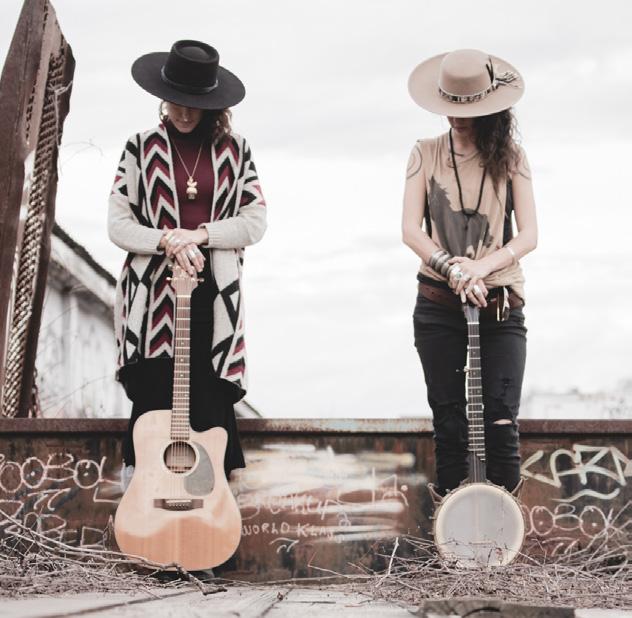
CS: Right now, it’s the injustices of race and class and patriarchy. We are collectively witnessing how systematic racism and oppression is built into the very fabric of our
country. This is not a surprise to most of us who have been working on justice initiatives for many years, however the immediacy of action and attention has shifted. I believe art has and will continue to play crucial roles in the rebuilding of communities post Covid and post police reformation and post climate crisis. We need to vote, organize, strategize, reform, educate, meditate, and get our country on a track of healing. It’s a ton of work, but the time is ripe. CS: Carlton Turner from a nonprofit we are a part of called Alternate Roots. Jane Fonda. Our friends, Climbing Poetree. Winona LaDuke and Lyla June Johnson. Bob Marley and Playing For Change. Our mentor, Paul. Rosemary Gladstar. Xiuhtezcatl. All the youth climate activists, known and unknown. Benazir Bhutto. Bisa Butler, the incredible visual artist. Saul Williams. Aja Black. AOC. Our friend Mark Brand who is a chef and feeds homeless folk. The Obamas. Joanna Macy and Joan Halifax. The Dali Lama. Honestly, this list could go on for fourteen pages. There are so many good people, past and present, who work hard for the breath of the earth and the rights of the people. Let us not forget that and spend too much time paying attention to the ones who misstep. All these voices should be heard and wellknown.
CA: You recently released a remix of the song “Resilient” by your long time band member David Brown. You’ve so poignantly described the album version as “a song of resistance and empowerment to that which subdues or moves focus from the center. Resilient is for anyone who needs a reminder of the meaning of that word. Resilient: able to recoil or spring back into shape after bending, stretching, or being compressed. Written to affirm the feminine, affirm the leylines of the sacred, affirm the raucous power of a collective roar into the face of the restrictors and oppressors of the world.” Has this song and its message taken on new meaning
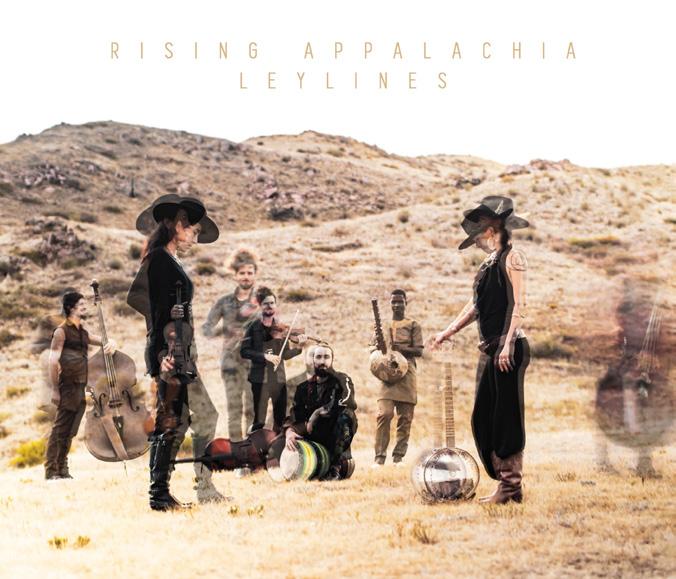
to you in light of the current times?
CS: I wouldn’t say new meaning, as it’s just as potent to its original message now as when it first released. But I would say new eyes, new vibrancy, and a new focus. This song (“Resilient”) is for everyone, but we dedicate it right now to our black brothers and sisters who are STILL working for equal rights and protection. May they be resilient, safe, protected, joyous, honored, and spared from the violence of the system. May we all take action in the turning of the tides.
CA: When you look back at the road you’ve traveled from Rising Appalachia’s humble beginnings busking and playing at farms to now having a global family that has gathered around your music and message, what would you say have been some of the most challenging aspects of the journey?
challenging part of the journey was the toll that constant travel takes on the body, mind, and soul. We LOVE our work and LOVE sharing music in beautiful spaces, even LOVE to travel and experience the diversity of the world, however the sleeplessness and heavy lifting of touring is not slight. We were growing tired of being in new towns every night, taking all the trains and planes and bus drives, leaving our gardens and partners and families at home. We are looking now for a more meaningful and impactful way to weave our music into global communities. We will re-emerge with our Slow Music Movement. Residencies. Teaching song workshops for a week that culminate in a big community concert. Collaborations with conscious brands. Political work. Permaculture work. Educational work.
CA: Has it helped you to persevere and made it just a little sweeter to be co-creating, singing and harmonizing, growing and evolving, and building a thriving career as
CS: Of course and absolutely. Leah and I are blood sisters, life partners, and creative cohorts. That is an incredible thing, something we try not to take for granted. It makes the road less lonely as well as keeps the ego humbled in a profession that serves the ego first. We balance and shift our weight between one another and that keeps Rising Appalachia a growing, ever evolving, family-led project.
CA: Have either of you ever flirted with the idea of exploring your own artistry outside of Rising Appalachia with a solo project or other collaborations?
CS: Yes! And now more than ever. We are lucky to have countless artists all over the place that we collaborate with and are building with. The entire band, aside from myself, have solo projects that they tend to and water. I focus more these days on writing, some of which ends up in Rising Appalachia and most of which ends up elsewhere. I look forward to stretching that muscle more and more in the years to come.
CA: Can you tell us about the journey of a song and your songwriting process as a duo? How have you managed to both weave your creativity, your ideas, and your voices into one creation, one sound, and such a cohesive body of work?
CS: Well, they are each unique, like having different children with different things they want to do in this world. Some we “catch” from the ethers. Some we craft from the bottom-up like clay pots. Some are a collaborative throw down from all six band members in a jam session. Some are a nugget of a personal story whispered into the hole of the guitar.
That is what is fun about being an artist: you learn to allow each piece to be what it wants to be… lending your efforts but also somehow getting out of the way. It’s a delicate dance; a beautiful tango.
CA: What was it like to collaborate with Ani DiFranco on “Speak Out”? Can you share the story of how that collaboration came about?
CS: It was about fifteen years in the making. We are huge fans and would leave her love notes and presents at her shows, which she likely never received. Then slowly as we emerged as folk musicians, our circles got smaller and smaller and we had some shared friends. Then we met at our hometown music festival and said hello and she asked us to sing harmony on stage with her. Then we asked if she might sing on our record. It’s amazing, really, how a seed of an idea or a dream comes to fruition. Sometimes, it’s instant like lightning. Sometimes, it’s a slow wave coming in from way offshore. Either way, in my opinion, prayers and ideas are heard and received and come out when they are ready.
CA: A question on behalf of our community selected from submissions from our readers: “What daily practices would you recommend to boost confidence and for people wanting to express their voices and themselves more fully?”
CS: Sing! Sing in the shower. Sing along with your favorite artists. Start a singing group. Try writing a song, even if it turns out terrible. Flex the muscle that is your voice. Find freedom in opening that part of your body. The sooner the better. Join a songwriting class, even if it terrifies you.
CA: If you could send a direct text message to everyone on the planet, what would it say?
CS: Ha! Great question. Dear Michelle Obama: help us.
CA: Who are you currently listening to and loving? Any hidden gems that you would like to shine a light on?
CS: The impeccable Ibeyi sisters. Lots of Django Rheinhart and Robert Glasper. 4 Tet and Dirtwire. Nils Frahm and The Sudan Archives. The Tufted Titmouses’ and Cardinals that live right outside my window and offer me birdsong every morning. Tara Brach and her immensely helpful meditation podcasts. Beautiful Chorus. The Ganapati meditation. Toumani Diabate, Arouna Diarra, and Tinariwen.
ymore info: www.risingappalachia.com
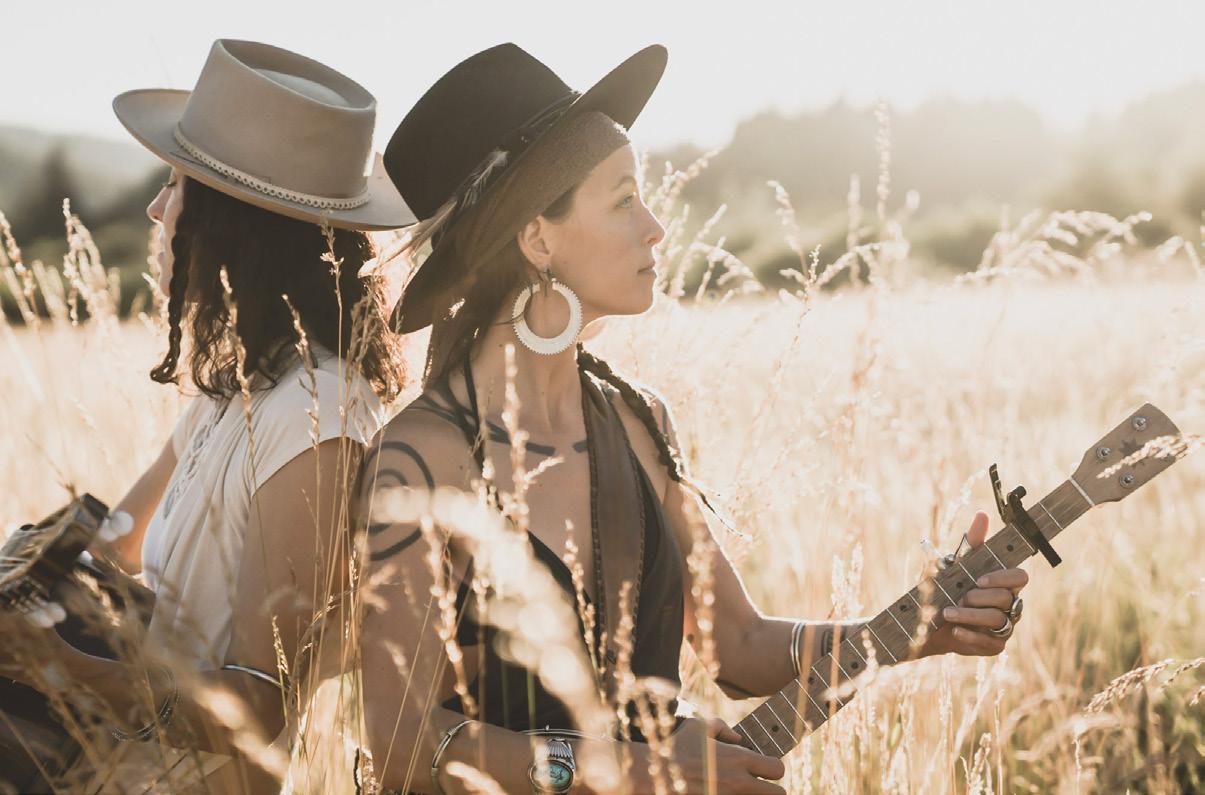
R i s i n g U p t o t h e Pa p e r M o o n w i t h Singer-Songwriter Joy Downer
By Ainsley Schoppel
One of ten children raised in Jamul, California, Joy (Bishop) Downer grew up surrounded by music. Her mother often played the piano and listened to musical soundtracks while her father, a drummer in high
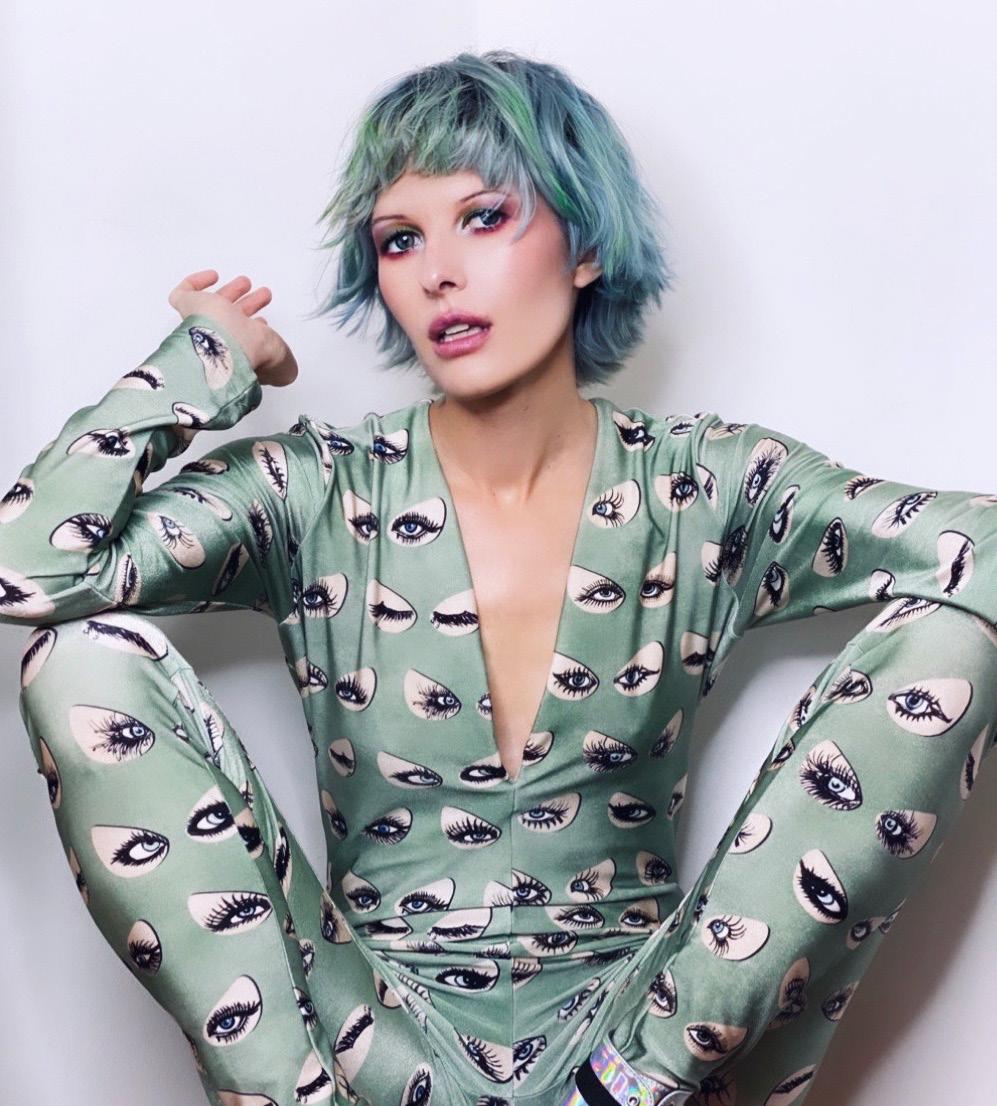
school, loved to play Beatles songs and listened to classic rock and roll, and country tunes. “We lived in a pink house with blue carpet, perched on the top of a hill with fruit trees and horses, lots of dirt to ride bikes, and a trampoline to get hurt on constantly,” she recalled. Many people in Joy’s community played instruments and sang, and she credits those childhood years with her ingrained love of music.

In grade school, Joy found ways to intertwine classroom learning with her affinity for and connection to music. She discovered that song writing could be used as a tool to help her learn and recall new topics. “It seemed to be the only way I could retain information,” Joy stated. She even used music and lyrical expression to help make sense of her own feelings. “I would also write about my feelings of depression,” she revealed. “Though I didn’t know what depression was at the time, and with no one to open up to about what I was feeling, music was my only form of therapy.” She continued to write into high school, with her lyrics and storytelling thematically leaning toward romance. Joy shared one of these early compositions with her then boyfriend who suggested that she try to sell her song to a “real singer” like Britney Spears. (In the following years, this irritating advice became something that Joy was happy to have ignored.) During her senior year of high school, Joy was homeschooled to allow for more time to be devoted to her burgeoning modeling career. As she focussed more of her time on this path, she traveled the world as a model for eight years, working and living in Australia, London, Los
Photo Credit: John Knipp
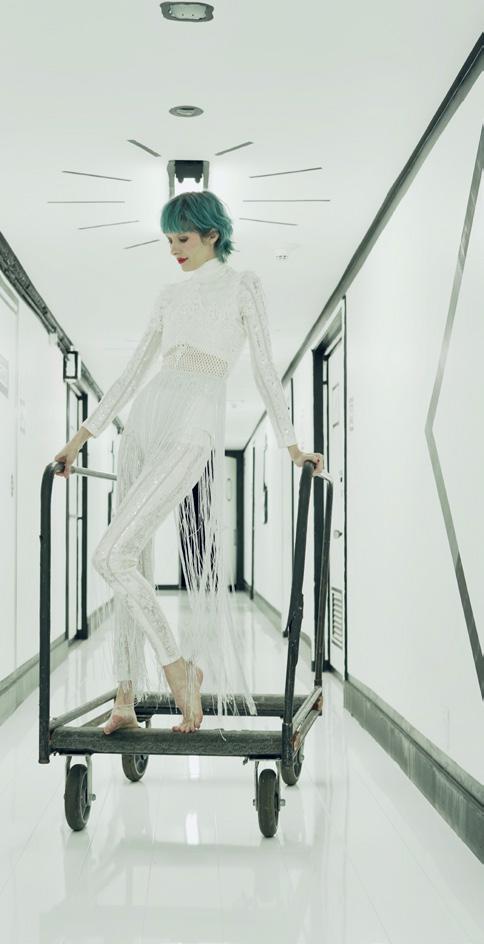
Angeles, and finally New York City. While living in New York in 2008, Joy decided to venture out to San Diego to visit her brother, Jon Bishop, a DJ on the forefront of the Southern California techno scene and a member of the band Crash Encore.
Joy met Jon at Capricorn Studios where he was recording with his band, and upon entering, she saw her future husband for the first time. “Inside the live room playing some really beautiful guitar sat Jeffery, my brother’s new best friend,” she recounted. The band played her a new song they’d been working on and Joy immediately heard a melody
that intrigued her. Jon and Jeffery encouraged her to record the track, and so it serendipitously happened that Joy marked her first ever studio recording.
Joy hadn’t returned to New York City for very long when Jon and Jeffery requested her return to San Diego to further collaborate on the album. The decision to return and dive further into that album became a turning point in Joy’s life, both personally and professionally.
When Joy realized she needed to remain in California for the next chapter of her life, Jon suggested she stay with Jeffery. “The joke here
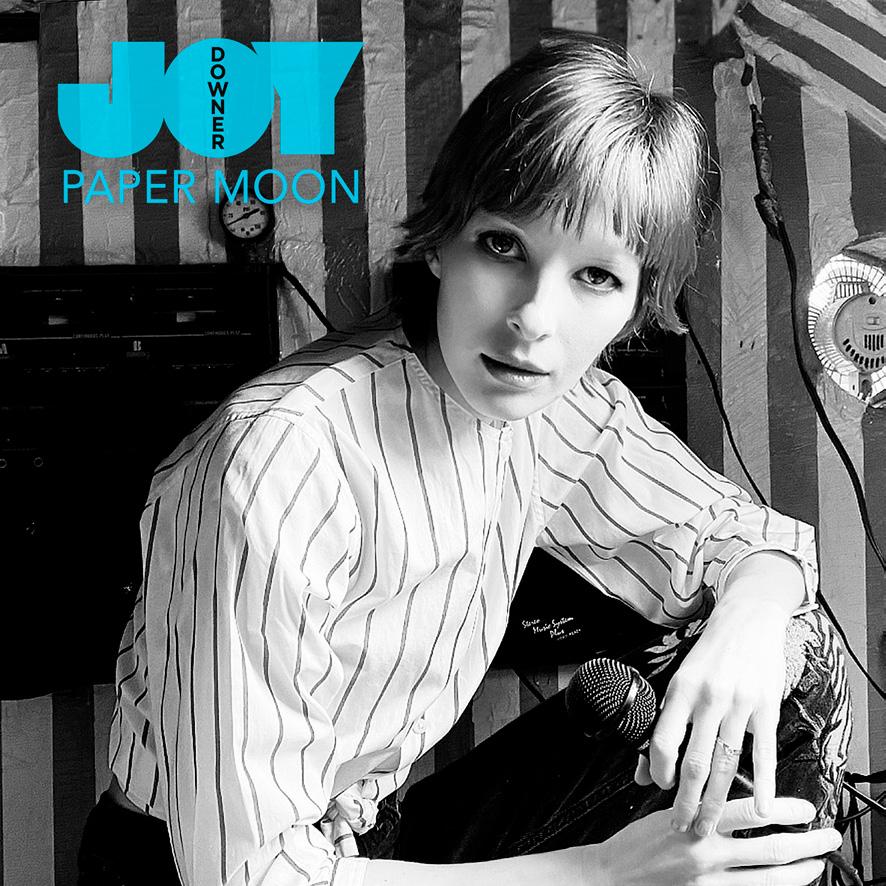
is that I moved in and never moved out,” Joy mused. The two connected romantically and moved to Los Angeles so Joy could reignite her modeling career while the couple worked on their music in parallel. However, Los Angeles’ high cost of living proved a challenge, and the couple found themselves working multiple jobs just to survive. As a result, their music shifted to the back burner for the next six years.
That all changed five years ago. “In 2015 I said, ‘Screw it! I’m quitting all my jobs and spending six months working on music,’” she said, “and I did just that.” Out of that focussed musical period came Joy’s debut solo EP, Radio Dreamer which she recorded with producer Rob Kolar in 2017. When Rob started touring with his own band, Joy decided to instead work on her debut LP Paper Moon at home with Jeffery. “We’ve had the opportunity to really strengthen and home in on our musical capabilities,” said Joy of working with her husband. Doubling-down on her familial connection to music, Joy felt it was important to include her family members on the album. “I sampled voicemails from both my mom and dad, had my mom play piano, had my brother Jon sing and play guitar at the end, and my sister Jaime played some
Photo Credit: Lilly Keys
harmonium,” she explained. “There’s even a song I started writing at age seventeen that I didn’t ‘sell to a real singer like Britney Spears’ which is the opening track song, ‘A Song You’d Never Want to Hear’.” After three years of writing and recording in her home studio in Los Angeles, Joy Downer released Paper Moon on June fifth and it is a sweeping album displaying ranging inspirations from Broadway musicals to disco and punk rock. Selfdescribed as Alternative Dream Pop, Paper Moon highlights a seamless blend of Joy’s addictive vocal melodies, synths, drum machines, and guitars in a stunning collection of nine songs. Through the first weekend of the album’s release, Joy donated all proceeds to Black Lives Matter LA, and she continues to reach fans through Refinery29, BBC Radio, FLOOD, UPROXX, The Line of Best Fit, Blackbook, Popular, Apple Music, and Spotify. Joy’s music has been featured as the theme song for the Netflix original Series Spinning Out, and she was also recruited by renowned production duo Superhuman to cover “Somewhere Over the Rainbow” in a Honda television commercial. captures her current mindset and feelings, and song writing continues to provide her with her own form of restorative therapy. “I wrote most of my songs in a stream-ofconsciousness way,” she explained, “so if I’m asked what they mean, I’m often still trying to figure that out myself. So, I would say, whatever it means to you, that’s what it means.”







